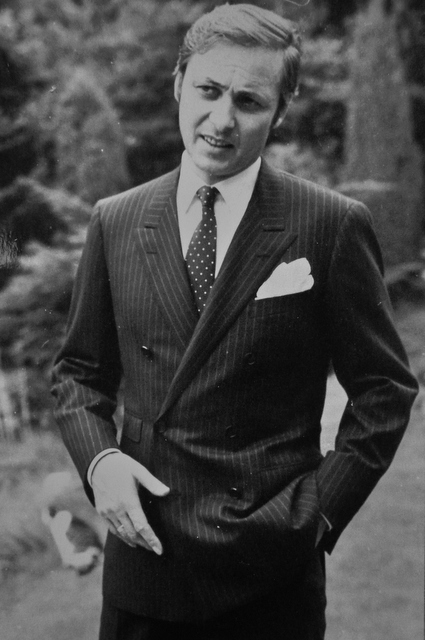I’ve always found Germany an interesting country stylistically – one with a rich bespoke past but little left today, perhaps hampered by its attitude to dress and to smart clothing in general. In order to give the country its due, I’ve asked writer Bernhard Roetzel to talk about how Germany came to this point, and some the peculiarities of its tailoring.
In a second piece he will relate his experiences with several bespoke German tailors, and give his reflections and recommendations today.
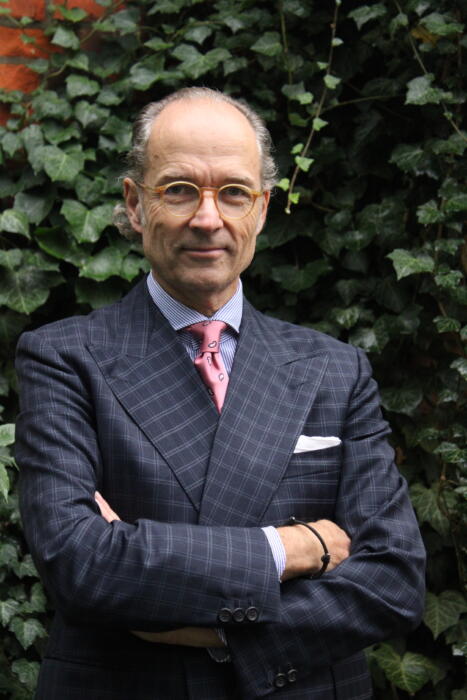
By Bernhard Roetzel (above)
When people start looking for tailors in Germany, they often ask if there is a traditional centre of tailoring or a region where the best tailors come from. The answer is no. Tailors can be found everywhere – in the cities, in small towns and even in rural regions. The explanation lies in German history.
Unlike in the UK or France but similar to Italy, there was no single German state until the Reich was founded in 1871. Before that there were nearly 40 sovereign states, each with a royal or ducal court and court tailors. So today tailors are still spread around.
Berlin became the capital in 1871 and grew quickly into a modern city. Thousands of tailors worked there. For them the years between 1900 and 1914 were the golden age, and many cutting systems were invented.
The one developed by the tailor and cutter Michael Müller in Munich (below) became the most successful. It was taught in the academy he founded in 1891, was regularly updated, and later became the foundation for the ready-to-wear industry when it grew in the 1960s. The majority of German tailors still use this system.
The dominance of this cutting system is probably why most German tailors reject the idea of a ‘house style’. M Müller & Son regularly offers a new, updated silhouette in line with fashion, and tailors seem to trust these suggestions more than their own ideas.
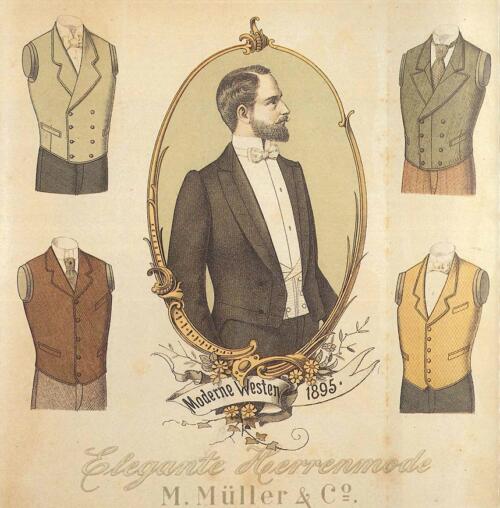
The grand days in Berlin
Berlin’s equivalent to the West End in terms of bespoke was Friedrichstraße and Unter den Linden, in the area known today as ‘Mitte’. The two most famous tailoring houses were Gerson and Hermann Hoffmann. The latter was purveyor to German Kaiser and his court, with at one point 10 cutters and 150 tailors.
The tailors in Berlin had a reputation for being the best in Germany. They were organised in a guild that had been founded in 1288, which took great care to uphold the standards of quality. For example, it classified all businesses by size, number of employees and quality, with tailors only allowed to charge prices that matched their category.
Tailoring flourished all over Germany in the early twentieth century, and there were tailors for every budget. The regional capitals each had their own fashionable tailors, and there were many good ones scattered across rural areas, spa towns like Baden-Baden or Bad Homburg, holiday areas in the Bavarian Alps, skiing resorts, and the affluent suburbs of Munich, Frankfurt, Mannheim and Stuttgart.

After Berlin was divided into sectors the number of tailors in West Berlin shrunk, but by the early 1950s the tailors guild still had about 1200 members. It was when the wall was built in 1961 that the slow demise of bespoke tailoring really started. By 1988, a year before the wall fell, there were only 60 bespoke tailors left in West Berlin.
In the GDR (East Germany) the situation was very different. They were cut off from supply in England, Scotland and Italy and locally woven fabrics were also hard to find. But tailors continued to work because the state-owned fashion industry couldn’t cater to everyone.
Not all tailoring businesses were nationalised, but the government planned and controlled where tailors could open shops. Interestingly, the lack of wealthy customers meant that tailored clothes had no prestige attached to them.
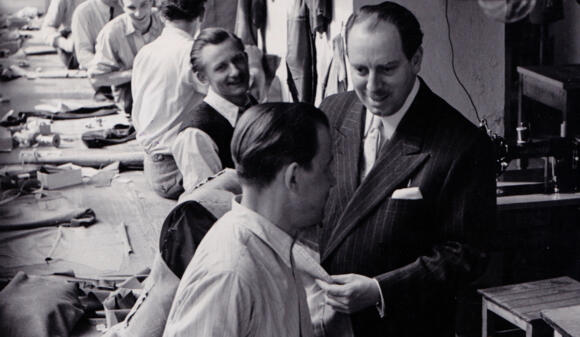
The 2000s renaissance
In the late 1990s I met a couple of the greats of German tailoring before they retired or died.
Arnulf in Berlin. Schmauder in Baden-Baden. Radermacher, Schaich, Westhoff and Ern in Düsseldorf. Staben and Brucker in Hamburg. Münch in Stuttgart. Stärkenberg and Röben in Cologne. Hussmüller, Brunner, Flingelli and Dietl in Munich.
Many had a good business until they retired, but couldn’t find someone who wanted to take over. Arnulf is still working but has moved his shop to Potsdam. He is probably the last living link to the past. Max Dietl (above) is the last big tailor still working. The present owner is Max Dietl junior: he is not a trained tailor and the bespoke is offered alongside handmade RTW from Italy.
In the early 2000s it looked like bespoke tailoring would die out. Apprentices were hard to find; the image of the profession was very bad and wages low. The cost of labour meant tailors found it hard to compete with RTW or MTM made in Eastern Europe or Asia.
Somehow some businesses survived to benefit from the new interest in bespoke that was fuelled by social media. This small renaissance brought new customers and it motivated young people learn the trade or stay there, instead of looking for a job in the fashion industry.
Now young people want to become tailors because they like handmade clothes or the sustainability of this trade. Some of these enthusiasts are pretty skilled at the outset, thanks to YouTube videos teaching cutting and sewing.

The situation today
Presently in Germany the tailoring scene is pretty multifaceted. Very few of the old tailors born before 1945 are still working, and very few craftspeople are below thirty. There are no more big businesses – perhaps defined by those with more than 10 fully employed tailors. The typical business is run by the owner and cutter, with one fully employed tailor or an apprentice.
Outworkers are rarely employed, mainly because there aren’t any. There is no tradition in Germany of tailors working from home as in in the UK. And in particular, there is no tradition of outworkers specialising in coatmaking, trousermaking or vestmaking. In Germany tailors are trained to make everything.
The training, though, has always been highly standardised and regulated. The apprenticeship lasts three years, with apprentices learning the making side from a tailor who pays them a small wage. The apprentice also visits a vocational school. Cutting and fitting is taught when the ‘Geselle’ decides to attend a Meisterschule, which prepares him for the examination by the local tailors’ guild.
That training has a strong focus on the mathematical correctness of fit. As a result, German tailors are very good at pattern making, and the focus on precision cutting means good pattern matching.
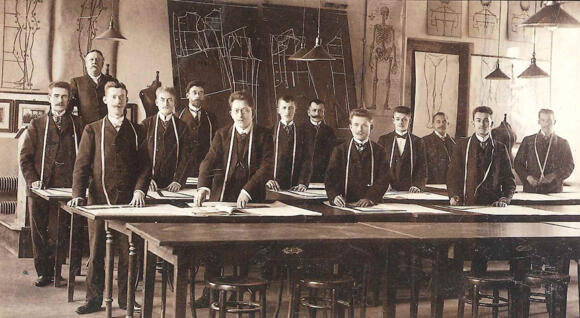
German tailoring is not stiff
Most German tailors are less preoccupied with elegance, and there is less reverence for the beauty of handwork. Still, the quality of the tailoring is usually very good. Contrary to an ineradicable preconception German tailoring is not heavy or stiff.
When fabrics became lighter in the 1970s tailors learned to make them up with less padding. But customers from the old generation often liked their jacket to be very shaped, so many tailors continued with this more structured garment until those customers died out.
The biggest problem for tailors today is, in my opinion, the general attitude towards clothing in Germany. The culture of dress is overall in a pretty bad state. German tailors rarely meet knowledgable customers who can inspire or challenge them.
Despite all this, there are tailors in Germany who deserve attention and can cater to those in Germany that want the beauty of bespoke. In a follow-up article I will discuss a few of the best, and relate my experiences with them.
Bernhard’s second article, recommending tailors working tailor in Germany, will be published soon
